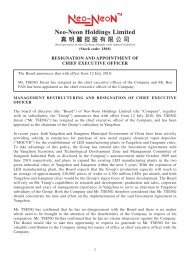Annual Report 2011 年 報 - Neo-Neon LED Lighting International Ltd
Annual Report 2011 年 報 - Neo-Neon LED Lighting International Ltd
Annual Report 2011 年 報 - Neo-Neon LED Lighting International Ltd
Create successful ePaper yourself
Turn your PDF publications into a flip-book with our unique Google optimized e-Paper software.
NotES to tHE CoNSoLIDAtED<br />
fINANCIAL StAtEMENtS<br />
6. FINANCIAL INSTRUMENTS (Continued)<br />
b. Financial risk management objectives and policies (Continued)<br />
Market risk (Continued)<br />
(i)<br />
Currency risk (Continued)<br />
Sensitivity analysis<br />
The Group is mainly exposed to currency of HK$, RMB and US$.<br />
The following table details the Group’s sensitivity to a 5% increase and decrease in HK$,<br />
RMB and US$ against the relevant functional currencies of the group entities. 5% represents<br />
management’s assessment of the reasonably possible change in foreign exchange rates. The<br />
sensitivity analysis includes only outstanding foreign currency denominated monetary items<br />
and adjusts their translation at the period end for a 5% change in foreign currency rates. The<br />
sensitivity analysis includes receivables, payables and external loans where the denomination is<br />
in a currency other than the functional currency of the relevant group entity. A negative number<br />
below indicates a decrease in profit for the period where RMB and US$ strengthen 5% against<br />
the functional currency of the respective group entities. For a 5% weakening of RMB and US$<br />
against the functional currency of the respective group entities, there would be an equal and<br />
opposite impact on the profit for the period. For HK$ impact, a positive number indicates a<br />
profit for the period where HK$ weaken 5% against the functional currency of the respective<br />
group entities. For a 5% weakening of HK$ against the functional currency of the respective<br />
group entities, there would be an equal and opposite impact on the profit for the period and the<br />
balances below would be negative.<br />
HK$ impact<br />
RMB impact<br />
US$ impact<br />
1.1.2010 1.1.2009 1.1.2010 1.1.2009 1.1.2010 1.1.2009<br />
to<br />
to to to to to<br />
31.3.<strong>2011</strong> 31.12.2009 31.3.<strong>2011</strong> 31.12.2009 31.3.<strong>2011</strong> 31.12.2009<br />
HK$’000<br />
HK$’000 HK$’000 HK$’000 HK$’000 HK$’000<br />
Decrease (44,411) (8,092) (i) (5,262) (255) (ii) (15,315) (32,885) (iii)<br />
(i)<br />
(ii)<br />
(iii)<br />
This is mainly attributable to the exposure outstanding on HK$ receivables, payables and external<br />
loans at period end in the Group relative to RMB.<br />
This is mainly attributable to the exposure outstanding on RMB receivables and payables at period<br />
end in the Group relative to HK$ and US$.<br />
This is mainly attributable to the exposure to outstanding US$ receivables and payables at the<br />
period end in the Group relative to RMB.<br />
In management’s opinion, the sensitivity analysis is unrepresentative of the inherent foreign<br />
exchange risk as the period end exposure does not reflect the exposure during the period. The<br />
financial impact on exchange difference from A$, Euro and NT$ is immaterial and therefore no<br />
sensitivity analysis has been prepared.<br />
ANNUAL REPORT <strong>2011</strong> 67




